 Phaistos
Phaistos
The
Palace of Phaistos lies on the East end of Kastri hill at the
end of the Mesara plain in Central Southern Crete. To the
north lies Psiloritis, the highest mountain in Crete. On the
slopes of Psiloritis is the Kamares cave, probably a religious
or cult centre for Phaistos and the Mesara plain. In this cave
a very fine pottery style was discovered from the Middle
Minoan period, which has been named Kamares Ware after the
cave in which it was found.
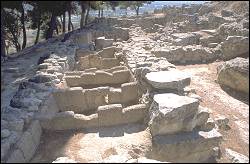 Kamares
ware has only been found at Palace sites like Phaistos and
Knossos, suggesting that it was specially produced for
whatever elite was based in the Palaces. To the south of
Phaistos are the Asterousia mountains beyond which lies the
Libyan Sea. To the south west is Kommos, the ancient port of
Phaistos and to the east, the vast Mesara plain. Kamares
ware has only been found at Palace sites like Phaistos and
Knossos, suggesting that it was specially produced for
whatever elite was based in the Palaces. To the south of
Phaistos are the Asterousia mountains beyond which lies the
Libyan Sea. To the south west is Kommos, the ancient port of
Phaistos and to the east, the vast Mesara plain.
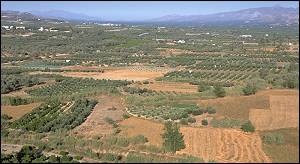 The
Palace was excavated by the Italian archaeologist Halbherr at
the beginning of the 20th century. The earliest settlements on
the site, which lies close to the Yeropotamos, one of the few
rivers in Crete to flow all year round, dates from the
Neolothic Period (c. 4000 BC) . It is likely that in the Early
Minoan period small settlements were scattered over the hill
on which the Palace later stood. Dark on light pottery (Agios
Onouphrios ware) has been found in the prepalatial levels on
the hill, but no Vasiliki ware from the Early Minoan II period
has been found on the site. The
Palace was excavated by the Italian archaeologist Halbherr at
the beginning of the 20th century. The earliest settlements on
the site, which lies close to the Yeropotamos, one of the few
rivers in Crete to flow all year round, dates from the
Neolothic Period (c. 4000 BC) . It is likely that in the Early
Minoan period small settlements were scattered over the hill
on which the Palace later stood. Dark on light pottery (Agios
Onouphrios ware) has been found in the prepalatial levels on
the hill, but no Vasiliki ware from the Early Minoan II period
has been found on the site.
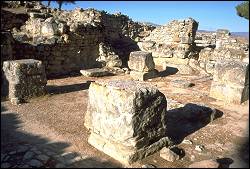 The
Old Palace was built on the site at the beginning of the
Second Millenium, known as the Protopalatial Period (c.
1900-1700). Twice it was severely damaged by earthquakes and
rebuilt so three distinct phases are visible to
archaeologists. Levi, who excavated here from 1950 to 1971
believed that the first two phases of the Old Palace of
Phaistos constitute the oldest Palatial buildings in Crete.
Other finds at the site include thousands of seal impressions
and some tablets containing the Linear A script from Middle
Minoan II. Linear A has also defied all attempts so far to
decipher it. The
Old Palace was built on the site at the beginning of the
Second Millenium, known as the Protopalatial Period (c.
1900-1700). Twice it was severely damaged by earthquakes and
rebuilt so three distinct phases are visible to
archaeologists. Levi, who excavated here from 1950 to 1971
believed that the first two phases of the Old Palace of
Phaistos constitute the oldest Palatial buildings in Crete.
Other finds at the site include thousands of seal impressions
and some tablets containing the Linear A script from Middle
Minoan II. Linear A has also defied all attempts so far to
decipher it.
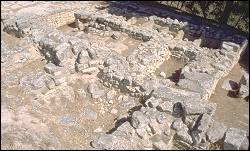 When
the Old Palace was finally destroyed a new palace was built on
the site. Fortunately for us, the builders of the new palace
did not destroy all traces of the old. In fact much of the old
palace was covered over at the time of the building of the new
palace in order to level the ground. Some of the old palace
can still be seen by visitors but much of it is accessible
only to the experts. When
the Old Palace was finally destroyed a new palace was built on
the site. Fortunately for us, the builders of the new palace
did not destroy all traces of the old. In fact much of the old
palace was covered over at the time of the building of the new
palace in order to level the ground. Some of the old palace
can still be seen by visitors but much of it is accessible
only to the experts.
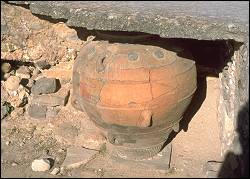 The New
Palace covers a smaller area than the old, thus enabling the
visitor to see some of the remains of the Old Palace,
including the area where the Phaistos Disc was discovered.
However, excavators have been surprised by the lack of finds
that one would expect at a Minoan Palace. No frescoes have
been found in the New Palace and there is a complete absence
of sealings and tablets. One view suggests that in the New
Palace period the importance of Phaistos decreased while that
of Agia Triada nearby continued to grow and that the two
settlements complemented eachother in some way. The New
Palace covers a smaller area than the old, thus enabling the
visitor to see some of the remains of the Old Palace,
including the area where the Phaistos Disc was discovered.
However, excavators have been surprised by the lack of finds
that one would expect at a Minoan Palace. No frescoes have
been found in the New Palace and there is a complete absence
of sealings and tablets. One view suggests that in the New
Palace period the importance of Phaistos decreased while that
of Agia Triada nearby continued to grow and that the two
settlements complemented eachother in some way.
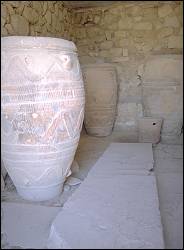 The site is
entered at the level of the Upper West Court, which was used
by both the old and the new palace. The Upper West Court is
joined to the Lower West Court by a staircase which was built
a the time of the upper court and was in use at the time of
the old palace. To the north of the court is a very high wall
and in front of this wall is the theatral area, with two
raised walkways. There are eight rows where spectators either
sat or stood to watch religious rites, ceremonies or whatever
else took place there. The site is
entered at the level of the Upper West Court, which was used
by both the old and the new palace. The Upper West Court is
joined to the Lower West Court by a staircase which was built
a the time of the upper court and was in use at the time of
the old palace. To the north of the court is a very high wall
and in front of this wall is the theatral area, with two
raised walkways. There are eight rows where spectators either
sat or stood to watch religious rites, ceremonies or whatever
else took place there.
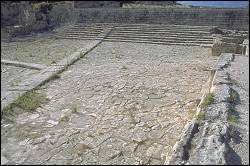 The main
entrance to the New Palace was from the West Court, up the
dozen steps of the 14 metre wide Magnificent Staircase, at the
top of which is an equally wide landing, behind which stood
the Monumental Propylaia. This structure is the forerunner of
the Propylaia of Classical Greek times. The main
entrance to the New Palace was from the West Court, up the
dozen steps of the 14 metre wide Magnificent Staircase, at the
top of which is an equally wide landing, behind which stood
the Monumental Propylaia. This structure is the forerunner of
the Propylaia of Classical Greek times.
 Between the
landing and the actual entrance itself, were two porticos.
Hutchinson points out that if the West entrance to palaces was
direct, then it was small, but if it was indirect then it was
grand. Here, the main entrance does not lead directly into the
Central Court and is very grand. Between the
landing and the actual entrance itself, were two porticos.
Hutchinson points out that if the West entrance to palaces was
direct, then it was small, but if it was indirect then it was
grand. Here, the main entrance does not lead directly into the
Central Court and is very grand.
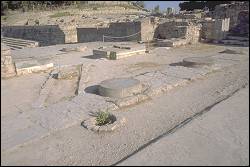 To the south
of the Propylaia is to be found the Palace magazine or storage
area. This consisted of ten rooms, five on each side, opening
onto an east-west corridor, which at its east end opened out
into a two-columned hall with a portico facing the Central
Court. One storage room remains in tact with a number of
pithoi inside (see photo above). To the south
of the Propylaia is to be found the Palace magazine or storage
area. This consisted of ten rooms, five on each side, opening
onto an east-west corridor, which at its east end opened out
into a two-columned hall with a portico facing the Central
Court. One storage room remains in tact with a number of
pithoi inside (see photo above).
 The Central
Court lies to the east of the magazines. It measured 55 metres
by 25 metres. The South East part of the Central Court is now
missing. Given the large number of corridors which lead to the
Central Court, it must have been central to the life of the
Palace itself. It was lined on two sides by porticos with
alternating columns and pillars. The Central
Court lies to the east of the magazines. It measured 55 metres
by 25 metres. The South East part of the Central Court is now
missing. Given the large number of corridors which lead to the
Central Court, it must have been central to the life of the
Palace itself. It was lined on two sides by porticos with
alternating columns and pillars.
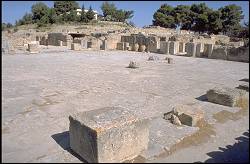 The
north-east wing of the palace is considered to have consisted
of artisans' workshops and the remains of a furnace for
smelting metal can still be seen in the courtyard. The
south-east wing collapsed some time in the past and the hill
has eroded to beyond the point where the it would have stood. The
north-east wing of the palace is considered to have consisted
of artisans' workshops and the remains of a furnace for
smelting metal can still be seen in the courtyard. The
south-east wing collapsed some time in the past and the hill
has eroded to beyond the point where the it would have stood.
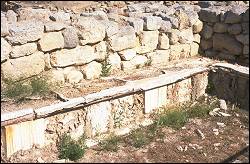 Much of the
West wing of the central court, south of the magazines, was
used for religious purposes. It contained a number of rooms
which opened directly onto the Central Court. Just south of
the corridor of the magazines, in the West Wing, there are two
rooms with benches lining the walls. Thes benches were covered
with gypsum, a material used extensively at Phaistos. Further
south there is a pillar crypt similar to those found at other
Palaces and also in the remains of the old palace at Phasitos,
but this one is on a rather more modest scale than, for
example, the one at Malia. Much of the
West wing of the central court, south of the magazines, was
used for religious purposes. It contained a number of rooms
which opened directly onto the Central Court. Just south of
the corridor of the magazines, in the West Wing, there are two
rooms with benches lining the walls. Thes benches were covered
with gypsum, a material used extensively at Phaistos. Further
south there is a pillar crypt similar to those found at other
Palaces and also in the remains of the old palace at Phasitos,
but this one is on a rather more modest scale than, for
example, the one at Malia.
 The area
also contained two lustral basins. Cult vases and figurines
were found in this part of the West Wing, and the shapes of
double axes were incised on the stone, all adding to evidence
of a religious use for the building. The area
also contained two lustral basins. Cult vases and figurines
were found in this part of the West Wing, and the shapes of
double axes were incised on the stone, all adding to evidence
of a religious use for the building.
 The
conventional view is that whereas the West Wing of the palaces
were used for religious and administrative purposes, the East
Wing contained the domestic apartments of the royal family.
However, a lustral basin was originally situated in the East
Wing and if the purpose of the lustral basin was religious
rather than hygenic, that would tell against the theory that
the East Wing comprised domestic quarters. The
conventional view is that whereas the West Wing of the palaces
were used for religious and administrative purposes, the East
Wing contained the domestic apartments of the royal family.
However, a lustral basin was originally situated in the East
Wing and if the purpose of the lustral basin was religious
rather than hygenic, that would tell against the theory that
the East Wing comprised domestic quarters.
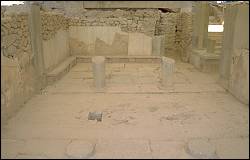 The
so-called Royal Apartments are in the north part of the
Palace, to the East of the Monumental Propylaia. The smaller
"Queen's Megaron" lies to the south of the larger
"King's Megaraon". These rooms would have had light
wells, porticoes and pier-and-door partitions which would have
enabled sections of the room to be closed off. The lower walls
and floors were lined with slabs of alabaster. To the west of
the King's room is possibly the best-preserved Lustral Basin
in Crete. The
so-called Royal Apartments are in the north part of the
Palace, to the East of the Monumental Propylaia. The smaller
"Queen's Megaron" lies to the south of the larger
"King's Megaraon". These rooms would have had light
wells, porticoes and pier-and-door partitions which would have
enabled sections of the room to be closed off. The lower walls
and floors were lined with slabs of alabaster. To the west of
the King's room is possibly the best-preserved Lustral Basin
in Crete.
 On the
slopes of the hill to the south of Phaistos and on level
ground below the hill stood the Minoan town. This is still
being excavated though part of it can be seen below from the
perimeter of the Palace site. On the
slopes of the hill to the south of Phaistos and on level
ground below the hill stood the Minoan town. This is still
being excavated though part of it can be seen below from the
perimeter of the Palace site.
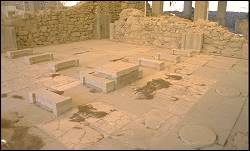 There are
many reasons why a visitor to Crete should make the effort to
visit Phaistos. It has the most beautiful setting of any of
the Minoan Palaces, it does not get quite so crowded as
Knossos and even in the summer it is possible to have the site
almost to oneself provided one arrives at opening time or
alternatively an hour or two before closing time. Finally, it
is a much more intimate site than Knossos where walkways of
scaffolding scar the Palace and so much of Knossos has been
roped off, preventing access to visitors, who must look from a
distance. There are
many reasons why a visitor to Crete should make the effort to
visit Phaistos. It has the most beautiful setting of any of
the Minoan Palaces, it does not get quite so crowded as
Knossos and even in the summer it is possible to have the site
almost to oneself provided one arrives at opening time or
alternatively an hour or two before closing time. Finally, it
is a much more intimate site than Knossos where walkways of
scaffolding scar the Palace and so much of Knossos has been
roped off, preventing access to visitors, who must look from a
distance.
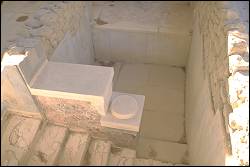 No doubt these
measures were necessary to protect the Palace of
Knossos from the hundreds of thousands of tourists
who swarm all over the site from April to October
each year. Similar measures may one day be necessary
at Phaistos. Until then, an early morning or early
evening visit will allow you to wander round the
site in a way that simply isn't possible at Knossos
and to break off from looking at the ruins to view
some of the most spectacular scenery that Crete has
to offer.
No doubt these
measures were necessary to protect the Palace of
Knossos from the hundreds of thousands of tourists
who swarm all over the site from April to October
each year. Similar measures may one day be necessary
at Phaistos. Until then, an early morning or early
evening visit will allow you to wander round the
site in a way that simply isn't possible at Knossos
and to break off from looking at the ruins to view
some of the most spectacular scenery that Crete has
to offer.
|